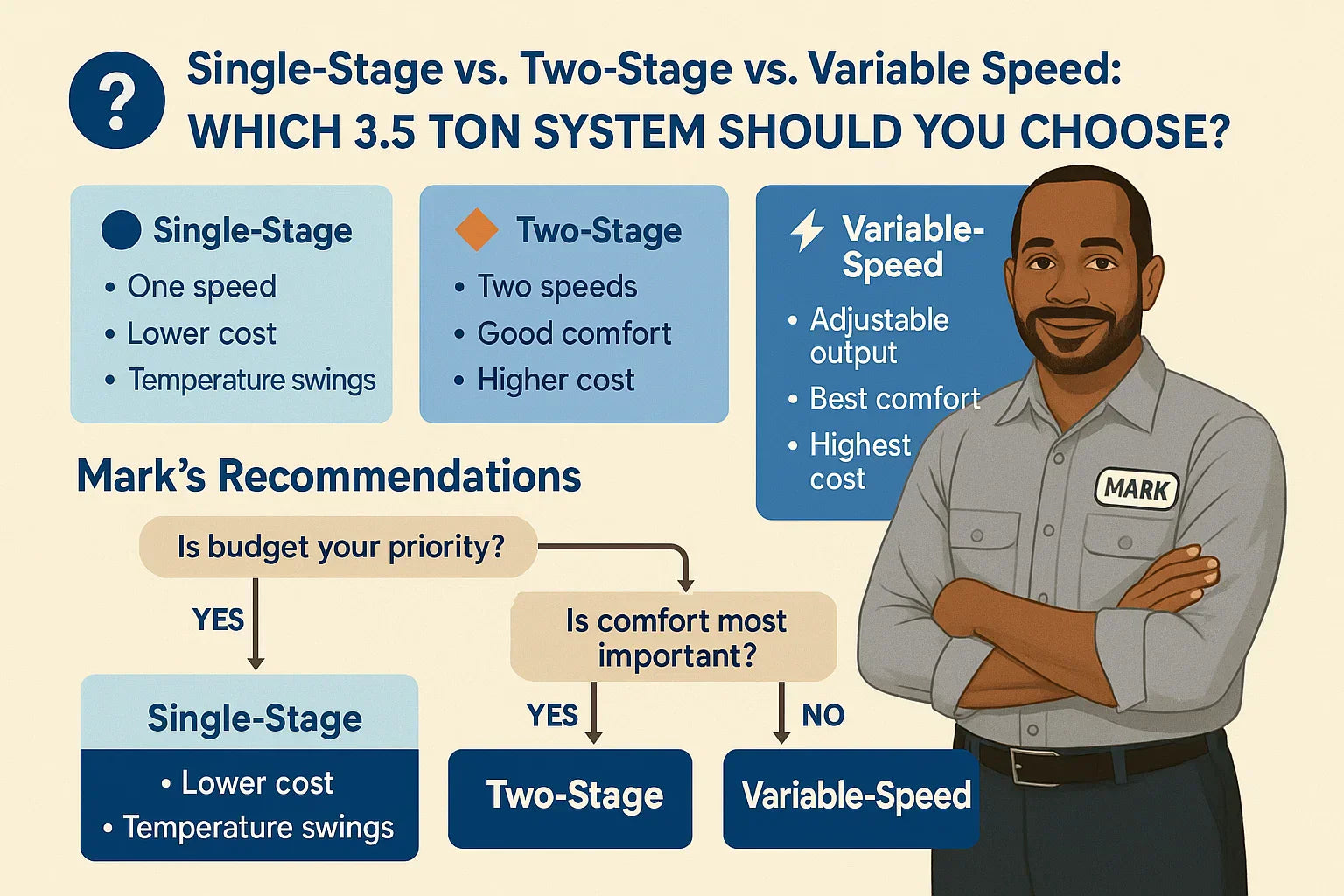Mark’s Home Comfort Guide for 2025 Buyers
🏠 Introduction: Why Staging Matters in a 3.5 Ton System
If you’re in the market for a 3.5 ton AC + furnace system, you’ve probably noticed that not all units are created equal. Beyond brand names and SEER2 ratings, there’s a major performance factor that changes how your system runs — the staging.
-
Single-stage: One speed — always running at 100%.
-
Two-stage: Two speeds — a lower setting for mild days and high for hot/cold extremes.
-
Variable-speed: Adjustable in small increments to match real-time needs.
The staging choice affects comfort, energy efficiency, lifespan, humidity control, and your monthly bills. In this guide, I’ll break down each type, give you real-world pricing for 2025, and help you figure out which system matches your budget, climate, and comfort expectations.
🔹 Single-Stage Systems
How It Works
A single-stage system runs at full capacity whenever it turns on, regardless of how much heating or cooling is actually needed. Think of it as an on/off light switch.
Pros:
-
✅ Lower upfront cost — typically the cheapest option.
-
✅ Simple design — fewer moving parts, less that can break.
-
✅ Easier repairs — most techs are familiar with single-stage systems.
Cons:
-
❌ Less efficient — burns more energy than necessary on mild days.
-
❌ Temperature swings — can lead to noticeable hot/cold cycles.
-
❌ Higher humidity in summer — shorter run cycles remove less moisture.
Price Range (3.5 Ton in 2025):
-
Equipment only: $2,600 – $4,200
-
Installed: $6,500 – $9,000
🔸 Two-Stage Systems
How It Works
A two-stage system operates at two output levels — usually around 70% capacity for mild days and 100% for extreme conditions. It’s like having a low and high gear.
Pros:
-
✅ Better comfort — runs longer at lower power, reducing temperature swings.
-
✅ Improved humidity control — longer cycles remove more moisture.
-
✅ Quieter operation — low stage is less noisy.
-
✅ Energy savings — typically 5–15% more efficient than single-stage.
Cons:
-
❌ Higher upfront cost — more complex compressor and controls.
-
❌ More parts to service — though still considered reliable.
Price Range (3.5 Ton in 2025):
-
Equipment only: $3,200 – $4,800
-
Installed: $8,000 – $11,000
⚡ Variable-Speed Systems
How It Works
A variable-speed system can adjust capacity in small increments (often 1% at a time) from as low as 20–30% up to 100%, constantly matching output to real-time needs. Think of it as a dimmer switch for your comfort.
Pros:
-
✅ Maximum comfort — holds temperature within 1–2 degrees of the setpoint.
-
✅ Best humidity control — long, gentle cycles wring out more moisture.
-
✅ Highest efficiency — can save 20–30% vs. single-stage.
-
✅ Quietest option — runs on low speed most of the time.
Cons:
-
❌ Highest upfront cost — most advanced compressors and electronics.
-
❌ Specialized repairs — parts can be more expensive, techs may need training.
Price Range (3.5 Ton in 2025):
-
Equipment only: $3,800 – $6,000
-
Installed: $9,500 – $13,500
📊 Side-by-Side Comparison
| Feature | Single-Stage | Two-Stage | Variable-Speed |
|---|---|---|---|
| Upfront Cost | $6.5k–$9k | $8k–$11k | $9.5k–$13.5k |
| Efficiency (SEER2) | 14.3–15.2 | 15–17 | 17–20+ |
| Humidity Control | Fair | Good | Excellent |
| Noise Level | Moderate | Low | Very low |
| Repair Cost | Low | Medium | High |
| Comfort | Good | Better | Best |
| Best Fit | Budget builds | Most homes | Comfort-first homes |
💲 Energy Savings Over Time
Upgrading from a single-stage to two-stage or variable-speed can pay off in reduced utility bills — especially if you live in a climate that demands long cooling or heating seasons.
Example:
-
Single-stage: $1,200/year cooling cost
-
Two-stage: ~$1,020/year (15% savings)
-
Variable-speed: ~$900/year (25% savings)
Over 10 years, that’s:
-
Two-stage: ~$1,800 saved
-
Variable-speed: ~$3,000 saved
🌎 Climate & Lifestyle Considerations
Hot & Humid
-
Best choice: Variable-speed or two-stage for superior dehumidification.
Mild Climate
-
Best choice: Two-stage balances cost and comfort; single-stage if budget is tight.
Cold Winters
-
Furnace AFUE becomes more important; pairing a variable-speed blower with even a single or two-stage AC can boost heating comfort.
🛠 Maintenance & Reliability
-
Single-stage: Simplest, least expensive to maintain.
-
Two-stage: Slightly higher maintenance due to additional controls.
-
Variable-speed: Most parts, most advanced — but often the longest lifespan when properly maintained.
📌 Mark’s Recommendations
-
Budget-conscious: Go single-stage, but prioritize proper sizing via Manual J.
-
Comfort-focused: Two-stage offers a great middle ground.
-
Long-term investment: Variable-speed delivers the best comfort and savings over time.
📎 Verified External References
In the next topic we will read more about: Gas Furnace vs. Electric Furnace Pairing for a 3.5 Ton AC: Pros, Cons & Efficiency Ratings







